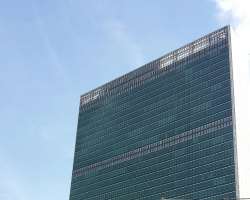Timetable Change For Humanity

The new Global Sustainable Development Agenda for the next fifteen years was adopted at the current UN-Summit in New York, providing people with disabilities with hope for social equality and inclusion. Now everything depends on how words will be put into action.
Light for the World/New York – Friday, September 25th the United Nations in New York agreed on 17 new Sustainable Development Goals (SDGs) and further 169 targets. The new SDGs will not only focus on the Global South as did its predecessor MDGs (Millennium Development Goals) but are directed at the whole world.
In other words all nation states take on the responsibility of applying this new agenda and therefor will have to come up with their own strategies. Until the year 2030 the new Global Goals will have a strong influence on international development cooperation as well as on climate politics.
The agenda’s strong focus on the disadvantaged members of society is truly revolutionary. Especially for persons with disabilities - who in the past had been almost completely left out - the agenda’s new Goals bring about hope for social equality and inclusion. Four of the seventeen goals explicitly mention persons with disabilities and eleven more general references to disabilities are included in the text. “The new sustainable development agenda embodies the aspirations of people everywhere for lives of peace, security and dignity on a healthy planet” says UN Secretary-General Ban Ki-moon.
Together with the international advocacy movement for the disabled LIGHT FOR THE WORLD has been lobbying for implementing the rights for inclusion and for barrier-free working environments in the agenda. The actual references in the context of education, employment and infrastructure as well as against inequality give hope that the vicious circle of poverty, disability and discrimination will come to an end. “This is a success of historic dimensions for inclusive policies and development cooperation” says Rupert Roniger, Managing Director of LIGHT FOR THE WORLD.
The path towards the year 2030 is not free from hurdles. All nation states will have to take their responsibilities and their commitment to the new agenda very seriously in order to achieve more than just bewitching words. As Magdalena Kern, representative of LIGHT FOR THE WORLD at the UN-Summit says: “In order to turn words into action a very strong commitment on a political and on a general level will be necessary. Participation is all - of the civil society as well as especially of the most disadvantaged members of society.” A further necessity is the sufficient financial support of poorer regions by the privileged north. “The promise of the donor countries to dedicate 0,7 percent of their gross national income to development has been renewed in the new agenda, now the deadline to reach this goal is 2030. Looking at current developments as the refugee crises in many parts of our world makes it clear that reliable programs are needed more urgently than ever” says Kern and adds: “It is an incredible contradiction to participate in the decision of this ambitious global agenda on the one hand, and on the other hand to suffocate our national development initiatives providing support in the Global South.”
It is a fact: the necessity of creating awareness through global advocacy movements for the disabled is a lasting one and so is the claim for embedding the concept of inclusion into all SDG programs which so far is not the case when it comes to such important goals as poverty, women’s rights and health. In order to change this, the help of all participating actors will be required. Kern: “Yesterday’s resolution is the guide book for our journey towards the year 2030. Now it is upon all of us to reach the destination – always keeping in mind the SDG-motto “leave no one behind”.
Weblinks:
http://www.un.org/sustainabledevelopment/sustainable-development-goals/
www.light-for-the-world.org
The reproduction of these images is free of charge if the full credit line “Light for the World“ is mentioned.
Background information:
Every seventh person on this planet lives with a disability according to the World Report on Disability commissioned by WHO and World Bank 2011. And what’s more, these figures are on the increase. Despite the fact that the majority of disabled people can be found in developing countries, developed countries just as well are faced with a notable increase in this population group due to the ageing of their societies. With a UN Convention ratified to date by 157 nations, the United Nations have done a lot in order to move this population group and their struggles from the outskirts to the centre of each society – in all areas of life, from inclusive schooling to disaster relief and development cooperation.
